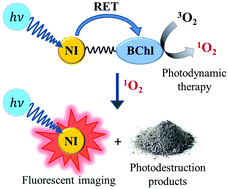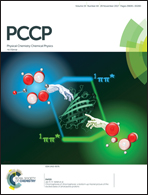A novel bacteriochlorin–styrylnaphthalimide conjugate for simultaneous photodynamic therapy and fluorescence imaging†
Abstract
Propargyl-152,173-dimethoxy-131-amide of bacteriochlorin e (BChl) and a 4-(4-N,N-dimethylaminostyryl)-N-alkyl-1,8-naphthalimide bearing azide group in the N-alkyl fragment were conjugated by the copper(I)-catalyzed 1,3-dipolar cycloaddition to produce a novel dyad compound BChl–NI for anticancer photodynamic therapy (PDT) combining the modalities of a photosensitizer (PS) and a fluorescence imaging agent. A precise photophysical investigation of the conjugate in solution using steady-state and time-resolved optical spectroscopy revealed that the presence of the naphthalimide (NI) fragment does not decrease the photosensitizing ability of the bacteriochlorin (BChl) core as compared with BChl; however, the fluorescence of naphthalimide is completely quenched due to resonance energy transfer (RET) to BChl. It has been shown that the BChl–NI conjugate penetrates into human lung adenocarcinoma A549 cells, and accumulates in the cytoplasm where it has a mixed granular-diffuse distribution. Both NI and BChl fluorescence in vitro provides registration of bright images showing perfectly intracellular distribution of BChl–NI. The ability of NI to emit light upon excitation in imaging experiments has been found to be due to hampering of RET as a result of photodestruction of the energy acceptor BChl unit. Phototoxicity studies have shown that the BChl–NI conjugate is not toxic for A549 cells at tested concentrations (<8 μM) without light-induced activation. At the same time, the concentration-dependent killing of cells is observed upon the excitation of the bacteriochlorin moiety with red light that occurs due to reactive oxygen species formation. The presented data demonstrate that the BChl–NI conjugate is a promissing dual function agent for cancer diagnostics and therapy.



 Please wait while we load your content...
Please wait while we load your content...